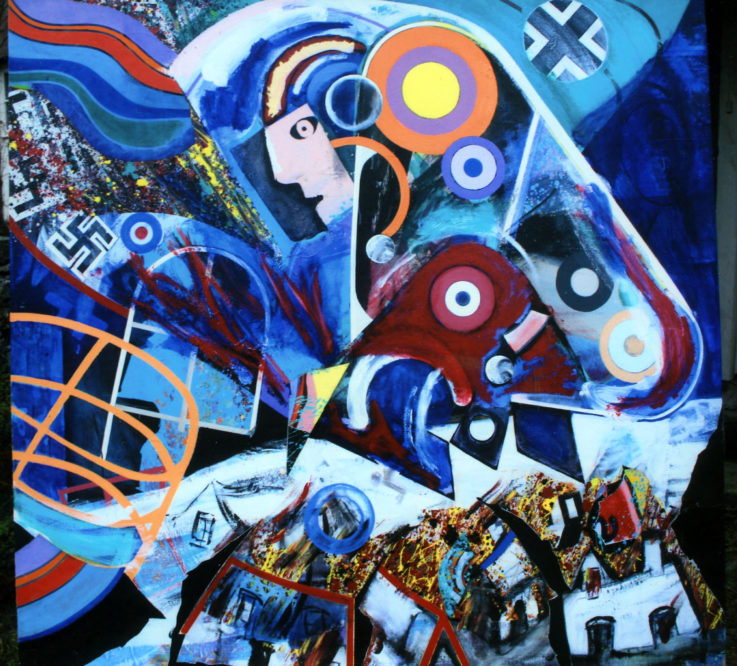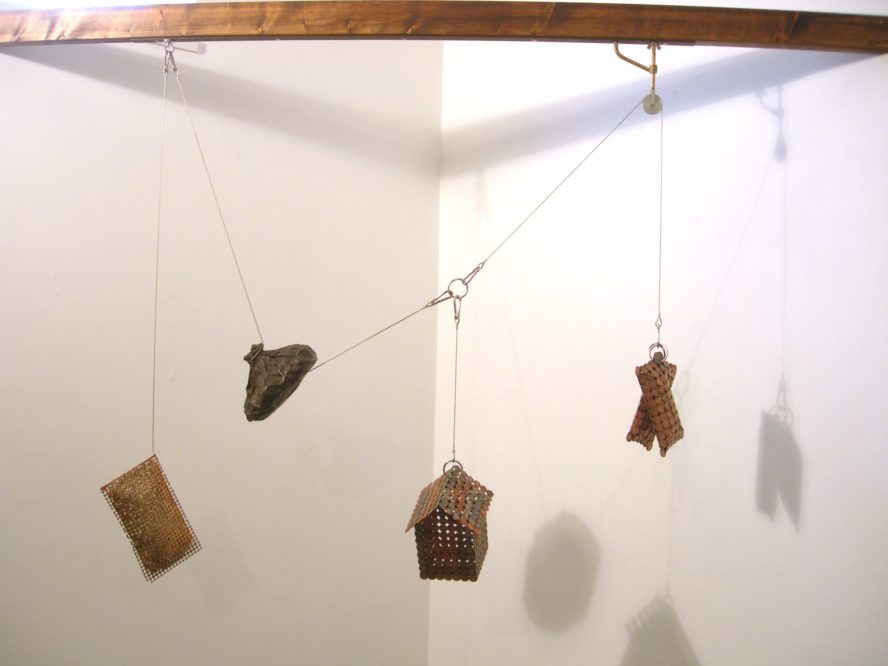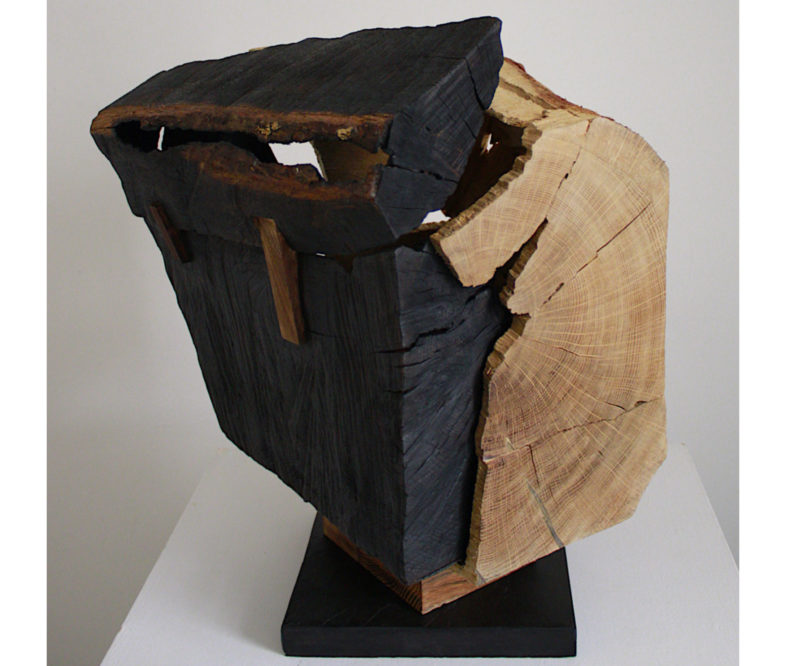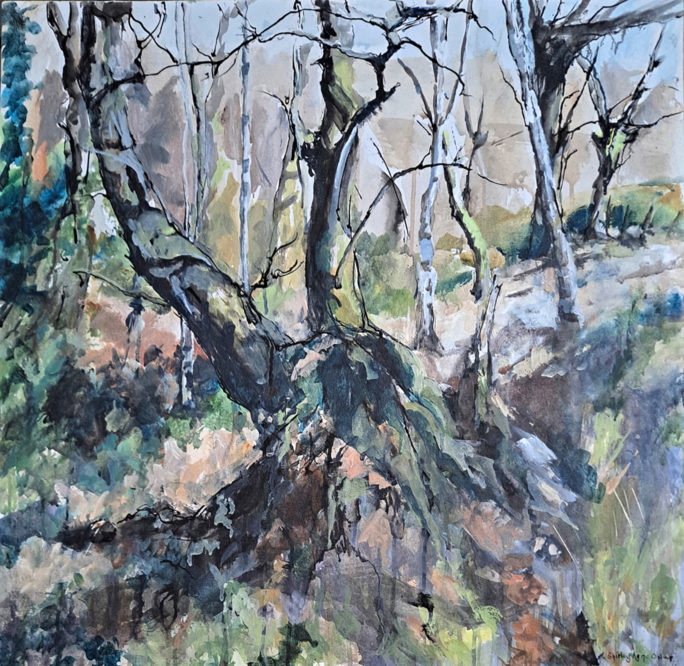Visual art: Making Space/Shaping Space

A new exhibition by the Welsh Group at Cardiff’s West Wharf gallery explores the relationship between physical space and the connections that visual images and objects have to space. ‘Making Space/Shaping Space’ comprises two sculptors and two painters with each artist dealing with space either literally or implicitly, directly or obliquely, often in unexpected ways.
Robert Macdonald has been using space as a subject in a way that connects with his personal. As a student at the Royal College of Art he explored feelings related to the Second World War when his family home was destroyed in a bombing raid, this is a subject that he has returned to in recent years – the loss of a very personal physical space.
The wartime Blitz was in the most literal sense a way of making and shaping space. I have chosen that as my artistic theme. I was a boy of seven in 1942 when we lost our family home in a German bombing raid. All through my artistic life images of that event have pushed their way into my picture-making.
A few years ago I was asked by the Swansea Print Workshop to take part in a project commemorating Dylan Thomas’s centenary. We had to make a print based on whatever example of the poet’s writing we felt most connected to. I chose his prose work ‘Return Journey’ in which he described returning to Swansea after it had been bombed. In my etching I portrayed Dylan amid the ruins of Swansea with overhead the ghostly forms of German aircraft.
During the Second World War my father, a country veterinary surgeon, gave up his career to work as a radar technician on the South Coast. We lived in a highly militarised area and at night when air raid warnings sounded I and my three siblings would be taken to lie under the stout kitchen table. After the bombing I spent the rest of the war as an evacuee in Somerset until my father took us all to New Zealand to live in 1945. When I began painting art proved for me a way of coming to terms with our wartime and post-war upheavals. I discovered in it my own form of psychotherapy. I absorbed Paul Klee’s dictum to ‘take a line for a walk’ and my first art works were extended doodles. Years later I recognised in these ink drawings expressions of hidden trauma emerging in intriguingly symbolic form.
When I struggled to become an artist a sense of anxiety and destruction continually pushed to the surface of my work. At the age of 41 I went to study at the Royal College of Art and consciously explored in a series of large canvases these troubled memories.
I have never exhibited most of the art works I created over the years relating to this period of my life. I can exhibit work ranging from my mid-1950s ink drawings inspired by Paul Klee to the big canvases created in the 1970s at the Royal College of Art to my Swansea etchings and a wood engraving created earlier this year of all us children sleeping under the kitchen table.

Robert Harding describes his work as ‘object-based sculpture that is a dialogue between physical space and material’ His work explores the connection between the work and the space, between the floor or shelf, the vertical walls or the ceiling.
‘Space is the breath of art’ suggested the architect Frank Lloyd Wright. For me, space is the first frontier in my sculptural world. No starship is required! I make sculpture that is a dialogue between physical space and material. Unlike a painter, I rarely indulge in illusion.
The material components in sculpture react with space in three main ways: they extend or move through space; they enclose or enfold space (creating hollows and voids); or they relate one to another across space.
We perceive sculpture in relation to the scale and orientation of our human bodies. For example, a piece that is two metres tall seems larger when it looms over us than when the same piece is lying on a floor. Indeed, our whole perception of space is determined by the fact that our adult eyes are about 7cm apart; before health & safety stopped me experimenting on students, I could demonstrate this by using 2 periscopes in a horizontal manner.
In an interior architectural space there are only three areas that a sculptor can explore: the floor (or an elevated floor – such as a shelf, pedestal, or plinth); the vertical walls; or suspension from the ceiling. The work at the West Wharf Gallery will explore all three areas.
By exploiting a corner, Stringing Us Along with Moneybags amalgamates two spaces: vertical walls and suspension. Tying together the elements with thin stainless-steel wire emphasises both the precariousness and interdependence of the structure and the gravitational force that dominates our lives.

Philippine Sowerby works with hard wood aiming to make visible the beauty around us and specifically present in the material, there is a dialogue between her and her piece. The work is dynamic, and often the observer can move multiple pieces forming new arrangements where new spaces are created.
My skill with wood comes from my teenage years, spending time building, mending, improving sailing dinghies.
I now work in rural Wales and my sculptures are made in the local wood that grows all around my studio. It is important for me that my work is in this ordinary, readily-available material that everyone knows.
I enjoy the process of working with the wood. As I work, the grain, texture and colour of the wood often prompt me to adjust my design so that the final piece reflects a balance between my intervention and the inherent structure of the wood. In my work, you will find strength and fragility interlinked and interdependent, as well as the play of darkness with light, and space with structure.
My work often reflects various circumstances in my life and makes allusion to my thoughts.
I worked in small and large scale, suitable for domestic settings and public places.

Shirley Anne Owen makes drawings and paintings that are primarily concerned with landscape. She has travelled along the coastal path undertaking a project to make drawings of the spaces. Large scale drawings continue to form a significant part of Shirley Anne Owen’s practice.
The focus of Yr Hen Goedwig is a small area of ancient woodland where, among the Birch, Holly and Rowan trees, are large Oak tree bases which have produced up to five younger trees – evidence of coppicing. There are a number of wild flowers along with ferns, mosses, lichens and fungi. Boundaries are banks and ditches topped in places by former cut and laid hedges which have grown out – making grotesque shapes. It will be interesting to observe the effects of climate change here.
Making Space/Shaping Space is at the West Wharf Gallery in Cardiff from 6 November – 30 December. 2024.
Support our Nation today
For the price of a cup of coffee a month you can help us create an independent, not-for-profit, national news service for the people of Wales, by the people of Wales.





An exhibition that looks to be worth seeing. But one must undertake some detective work to find out how to get to it. The linked West Wharf Gallery webpage describes the gallery as “Cardiff’s best kept secret” which may well be true as it doesn’t reveal any relevant information such as its location, address or opening hours. The gallery’s Facebook page isn’t much better as it hasn’t been updated for over a year. “Amateurish” is honestly too kind a description as amateurs are usually keen to connect their work with a wider public.